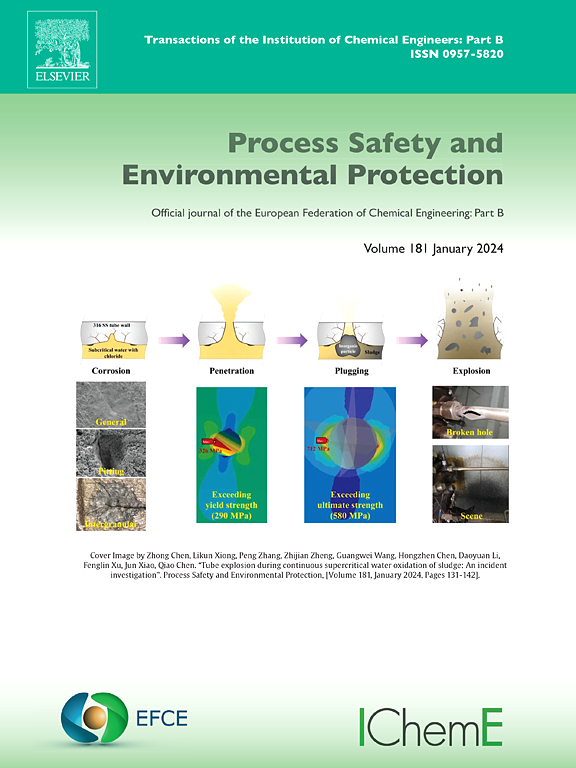Magnesium salt-synergistic roasting of mixed rare earth concentrate: killing two birds with one stone for enhanced rare earth leaching and fluorine fixation
IF 7.8
2区 环境科学与生态学
Q1 ENGINEERING, CHEMICAL
引用次数: 0
Abstract
Rare earth (RE), often referred to as the "vitamins" and "the mother of new materials" for modern industry, are crucial resources underpinning national competitiveness and industrial advancement. Bastnaesite and monazite are the primary sources ensuring a stable global supply of RE. The Bayan Obo deposit is the world's largest RE deposit and is characterized by the coexistence of bastnaesite and monazite. However, traditional methods for processing Bayan Obo mixed RE concentrate (MREC), such as the sulphating roasting and the NaOH decomposition method, pose environmental pollution concerns. This study proposes a novel method involving magnesium salt-assisted synergistic roasting of MREC to enhance RE decomposition and extraction. With this method, leaching efficiencies reached 87.66 % for rare earth oxides (REO), 93.91 % for P, and 37.65 % for F. Compared with the process without magnesium salts, REO and P extraction increased by 48 and 74 percentage points respectively, with notably reduced fluorine extraction. During roasting without additives, bastnaesite decomposes into rare earth oxides and oxyfluorides, whereas monazite remains stable. However, adding magnesium salts promotes the decomposition of monazite. MgCl2·6H2O initially decomposes into Mg(OH)Cl, which subsequently reacts with monazite, forming easily leachable rare earth oxychlorides and magnesium phosphate, thereby enhancing RE extraction from monazite. Simultaneously, Mg(OH)Cl interacts with bastnaesite and its decomposition products, generating easily leachable rare earth oxychlorides along with refractory rare earth oxides and MgF2, significantly reducing fluoride-containing wastewater. Furthermore, compared to MREC, the roasted product shows significantly enhanced pore characteristics, providing increased contact area and active reaction sites for subsequent leaching, thus facilitating RE extraction. Microscopically, after roasting, the formed rare earth oxychlorides exhibit a needle-like or whisker-like morphology with a relatively loose structure. After leaching, the residue primarily consists of monazite, rare earth oxides, and MgF2, with MgF2 displaying a dense, smooth, and lacteal. This study provides a novel and environmentally friendly approach for efficiently recovering rare earth from mixed rare earth concentrates.
镁盐-混合稀土精矿协同焙烧:一举两得提高稀土浸出和固氟效果
稀土被称为现代工业的“维生素”和“新材料之母”,是支撑国家竞争力和产业发展的重要资源。氟碳铈矿和独居石是确保全球稀土稳定供应的主要来源。巴彦鄂博矿床是世界上最大的稀土矿床,其特征是氟碳铈矿和独居石共存。然而,传统的处理巴彦鄂博混合稀土精矿(MREC)的方法,如硫酸盐焙烧法和NaOH分解法,存在环境污染问题。本研究提出了镁盐辅助MREC协同焙烧提高稀土分解和萃取的新方法。采用该方法,稀土氧化物(REO)的浸出效率为87.66 %,P的浸出效率为93.91 %,f的浸出效率为37.65 %。与不加镁盐的浸出工艺相比,REO和P的浸出率分别提高了48和74个百分点,氟的浸出率显著降低。在无添加剂的焙烧过程中,氟碳铈矿分解成稀土氧化物和氟氧化物,而独居石则保持稳定。镁盐的加入促进了独居石的分解。MgCl2·6H2O首先分解为Mg(OH)Cl, Mg(OH)Cl与独居石反应生成易浸出的稀土氯氧化物和磷酸镁,从而促进了独居石中稀土的提取。同时,Mg(OH)Cl与氟碳铈矿及其分解产物相互作用,生成易浸出的稀土氯氧化物以及难熔稀土氧化物和MgF2,显著减少含氟废水。与MREC相比,焙烧产物的孔隙特征显著增强,为后续浸出提供了更大的接触面积和活性反应位点,有利于稀土的提取。微观上,焙烧后形成的稀土氯氧化物呈针状或晶须状,结构相对松散。浸出后残渣主要由独居石、稀土氧化物和MgF2组成,MgF2呈致密、光滑、乳状。本研究为从混合稀土精矿中高效回收稀土提供了一种环保的新方法。
本文章由计算机程序翻译,如有差异,请以英文原文为准。
求助全文
约1分钟内获得全文
求助全文
来源期刊

Process Safety and Environmental Protection
环境科学-工程:化工
CiteScore
11.40
自引率
15.40%
发文量
929
审稿时长
8.0 months
期刊介绍:
The Process Safety and Environmental Protection (PSEP) journal is a leading international publication that focuses on the publication of high-quality, original research papers in the field of engineering, specifically those related to the safety of industrial processes and environmental protection. The journal encourages submissions that present new developments in safety and environmental aspects, particularly those that show how research findings can be applied in process engineering design and practice.
PSEP is particularly interested in research that brings fresh perspectives to established engineering principles, identifies unsolved problems, or suggests directions for future research. The journal also values contributions that push the boundaries of traditional engineering and welcomes multidisciplinary papers.
PSEP's articles are abstracted and indexed by a range of databases and services, which helps to ensure that the journal's research is accessible and recognized in the academic and professional communities. These databases include ANTE, Chemical Abstracts, Chemical Hazards in Industry, Current Contents, Elsevier Engineering Information database, Pascal Francis, Web of Science, Scopus, Engineering Information Database EnCompass LIT (Elsevier), and INSPEC. This wide coverage facilitates the dissemination of the journal's content to a global audience interested in process safety and environmental engineering.
 求助内容:
求助内容: 应助结果提醒方式:
应助结果提醒方式:


